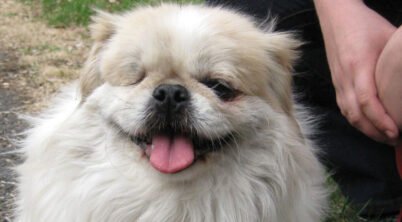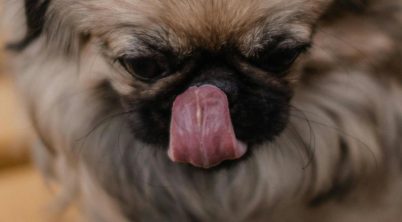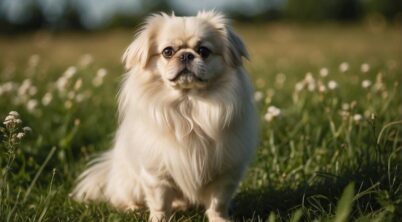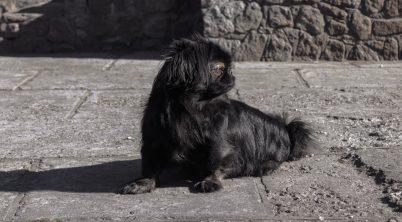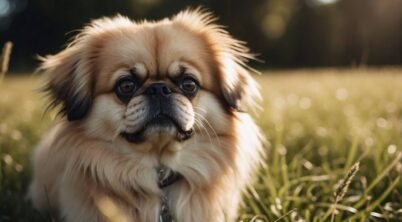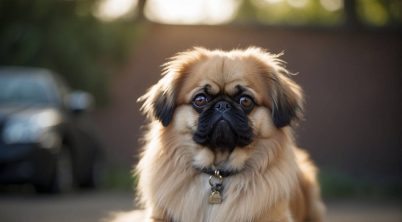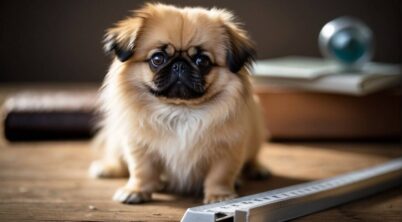The Pekingese, a toy breed with an illustrious history, hails from the ancient land of China. Bred for over two millennia, these dogs were once the cherished companions of Chinese royalty. Their history is steeped in lore and prestige, with stories suggesting that they were created to resemble ‘lion dogs’ of Chinese mythology. So cherished were these canines that they caught the attention of Western nobility, including Queen Victoria, after the Opium War in the mid-1800s, marking the start of their global spread.
Characteristically, Pekingese retain a regal demeanor and a distinctive appearance marked by their flat faces, big expressive eyes, and a luxuriously long, flowing coat. They are affectionately referred to as ‘Peke’, and while their small stature and calm temperament made them ideal lapdogs for nobility, their maintenance requires a commitment to regular grooming. Their double coat, especially abundant and longer around the neck and shoulders, necessitates a consistent grooming schedule to prevent matting and tangling.
Beyond their grooming needs, the Pekingese’s overall maintenance involves a balanced diet rich in protein, and regular exercise to keep them healthy and content. Despite their association with Chinese emperors of yore, Pekingese do not demand elaborate exercise regimes. Moderate daily walks and opportunities for play suffice. They thrive with interactive indoor games and enjoy the social engagement of a dog park, yet owners must be mindful of their sensitivity to extreme weather, owing to their thick coat and compact respiratory system.
Table of Contents
Breed Characteristics
The Pekingese is a toy dog breed with a set of distinct physical and behavioral traits. Its royal lineage is evident in its dignified and confident demeanor, and despite its small size, this breed possesses a bold and affectionate temperament.
Appearance
The Pekingese sports a noticeable V-shaped facial wrinkle and a short snout. Its large, expressive eyes add to the character of its face. The breed has a low body and slightly bowed limbs, contributing to a rolling gait.
Size and Weight
| Height | Weight |
|---|---|
| 6-9 inches (15-23 cm) | 7-14 pounds (3-6 kg) |
The Pekingese falls into the American Kennel Club’s toy class due to its compact stature.
Temperament
Pekingese dogs are known for being stubborn and independent, but they are also extremely affectionate and loyal to their families. They require consistent training and socialization due to their strong-willed nature.
Coat Colors
The breed’s lush double coat comes in various colors, including but not limited to:
- Red
- White
- Black and Tan
- Cream
- Gray
The coat can be a solid color or have a mix of shades that add to the Pekingese’s striking appearance.
Health and Wellness
Maintaining the health and wellness of a Pekingese is crucial in ensuring a long and quality life for this breed. Owners must be vigilant about certain breed-specific health issues, particularly those arising from its brachycephalic nature, and maintain proper eye, dental, and skin care.
Common Health Issues
Brachycephalic Syndrome: Due to their short skull shape, Pekingese are prone to brachycephalic syndrome which affects their breathing. It’s essential to monitor them, especially in hot weather or during exercise, to prevent respiratory distress.
Patellar Luxation: A condition where the knee cap dislocates, patellar luxation is relatively common in Pekingese and can cause pain or lameness. Regular veterinary check-ups can help identify and manage this condition early.
Skin Fold Dermatitis: In Pekingese, the skin folds can harbor moisture and bacteria, leading to skin fold dermatitis. Keeping these areas clean and dry is essential to preventing infection.
Eye Care
Given their prominent eyes, Pekingese are susceptible to various eye issues including but not limited to dryness, ulcers, and infections. It’s important to:
- Regularly clean around the eye area to remove any gunk or build-up.
- Schedule check-ups with the vet to detect any eye conditions early on.
Dental Hygiene
Dental issues can heavily affect a Pekingese’s overall health. Owners should:
- Brush their teeth regularly with vet-approved toothpaste to prevent plaque and tartar buildup.
- Provide dental chews and schedule professional cleanings as recommended by the veterinarian to maintain dental health and prevent potential teeth problems.
Diet and Nutrition
The Pekingese breed requires a balanced diet to maintain optimal health. Nutrition for Pekingese should comprise high-quality proteins, healthy fats, essential vitamins, and minerals. These components contribute to sustaining the dog’s energy levels and overall body condition. Small dog breeds like Pekingese have a slowed metabolism compared to larger breeds, so nutrient-dense food that is lower in calories helps prevent obesity.
Feeding Schedule:
- Puppies: 3-4 small meals per day
- Adults: 2 meals per day
Weight Management is critical for Pekingese. They are prone to gaining excess weight, so monitoring their food intake and adjusting portions to their activity level are vital. Obesity can lead to significant health issues, making it essential to provide a diet that maintains a healthy weight.
Suggested Components:
| Nutrients | Benefits |
|---|---|
| Protein | Muscle maintenance and repair |
| Fats | Healthy skin and coat |
| Carbohydrates | Digestible energy source |
| Fiber | Digestive health |
| Vitamins & Minerals | Immune system support |
Owners should note that Pekingese may require a diet that also considers their age, activity level, and health. For example, seniors may need diets catered to joint health, while active adults might require more calories. Consulting with a veterinarian can ensure they receive the proper diet and nutrition. Avoid foods high in fillers and sugars; these can be detrimental to the Pekingese’s health and contribute to unwanted weight gain.
Grooming Essentials
Proper grooming is crucial for a Pekingese’s health and wellbeing. This section provides an outline for maintaining their unique double coat, and tips for competent ear, nail, and skin care.
Coat Maintenance
The Pekingese’s luxurious double coat requires regular brushing to prevent matting and reduce shedding. Brushing should be done several times a week using a high-quality slicker brush and comb.
- Brush Types:
- Slicker Brush: For removing tangles and loose fur.
- Comb: To smooth the coat after brushing.
- Shedding: Pekingese dogs typically experience seasonal shedding. Regular brushing helps manage this process.
Bathing and Skin Care
Bathing a Pekingese should be done every few months or as needed to keep their coat and skin clean. Special attention should be paid to the skin folds, or wrinkles, which can trap dirt and moisture.
- Products:
- Shampoo: Use a mild, dog-specific shampoo.
- Conditioner: Optional, can help keep the coat soft.
- Drying: Gently towel dry or use a low-heat hairdryer, while brushing to prevent tangles.
Ear and Nail Care
A Pekingese’s ears must be kept clean to prevent infections, and regular trimming of their nails is important to maintain good paw health.
- Ear Cleaning:
- Clean the ears gently with a vet-approved solution.
- Check regularly for signs of infection.
- Nail Trimming:
- Trim the nails carefully to avoid cutting the quick.
- Regular trimming can prevent discomfort while walking.
Training and Behavior
Training a Pekingese requires patience due to their stubborn yet loving temperament. Effective training strategies can mold their inherently playful and affectionate behavior into well-mannered companionship.
Basic Obedience
Basic obedience training for Pekingese should focus on fundamental commands such as sit, stay, come, and heel. Consistency in training sessions helps address the breed’s stubborn streak, ensuring they understand what is expected. Positive reinforcement with treats and praise is effective for instilling obedience in a Pekingese.
- Commands to Start With:
- Sit: Teach them to sit on command by using treats to guide their bottom down.
- Stay: A crucial command for their safety, encouraging them to stay in place even at a distance.
- Come: Essential for recall, making sure they return when called in any situation.
- Heel: To maintain control during walks, especially if the Pekingese pulls on the leash.
Socialization
Socialization helps prevent the development of fear or aggression towards new experiences. A Pekingese should be gradually introduced to diverse environments, various people, and other animals. This reduces anxiety and promotes a well-adjusted adult dog. It is vital to start socialization early in puppyhood.
- Socialization Checklist:
- Different types of people (children, elderly, various uniforms)
- Various animals (other dog breeds, cats, etc.)
- Different sounds and environments (city sounds, park, home)
- Handling by groomers or veterinarians
Behavioral Issues
Pekingese can exhibit behavioral issues such as excessive barking or chewing if not properly trained or socialized. Early intervention and consistent training can correct such problems. Understanding that behavioral issues often stem from a lack of exercise or attention can guide owners to provide adequate stimulation and companionship.
- Common Issues and Remedies:
- Excessive barking: Address by teaching the quiet command and removing stimuli that trigger barking.
- Chewing: Provide ample chew toys and keep personal items out of reach.
- Separation anxiety: Gradually accustom them to being alone with positive reinforcement.
Exercise and Activity Needs
The Pekingese, with its distinctively long, flowing coat and dignified demeanor, has particular requirements when it comes to exercise and physical activity. Possessing a low to moderate energy level, these dogs fare well with modest amounts of daily activity. Here’s a breakdown of their exercise and activity needs:
- Daily Walks: Pekingese benefit from brief but regular walks. Aim for two 15-20 minute walks per day to keep them fit and prevent weight gain.
- Playtime: While outdoors is good, they are also quite content with indoor play. Engage them with toys or simple games like hide and seek which can stimulate them mentally and physically.
- Avoid Overheating: Due to their thick coats, care should be taken to avoid excessive physical exertion, especially in hot weather, to prevent overheating.
- Training: Short obedience training sessions not only exercise their bodies but also their minds, contributing to their overall well-being.
It is generally agreed that these dogs do not demand extensive physical activity. In fact, they often display an affectionate and playful spirit in manageable bursts of energy. When considering their exercise needs, it’s essential to account for their susceptibility to heat due to their coat and flat faces, which can make breathing difficult during strenuous activity.
Proper exercise for a Pekingese should balance physical activities with their comfort and health, always considering their unique physiology. Consistent, moderate exercise will support a Pekingese’s longevity and vitality.
Living With a Pekingese
Living with a Pekingese offers a unique blend of nobility and loyalty within compact companionship, suited for apartment dwellers and those seeking an alert yet affectionate canine friend.
Apartment Living
The Pekingese, or “Peke,” adapts well to apartment living due to its small size. It is crucial, however, to maintain a consistent grooming routine, as their luxurious coat requires daily brushing to prevent mats and tangles. Despite their ability to live comfortably within small spaces, Pekes do require regular exercise to stay healthy. Ideally, owners should aim for at least two 20-minute walks per day to keep their Pekingese in good shape.
Children and Other Pets
Pekes can coexist with children and other pets if socialization starts early. While they are loving and can be playful, Pekes may not tolerate rough handling; thus, interactions with very young children should be supervised. As for other pets, this breed can get along with other animals but it’s beneficial if they’re raised together. The Pekingese may display a measure of independence that can sometimes be mistaken for aloofness, but they’re typically social beings.
Companionship and Attention
Pekes thrive on affection and attention from their family members. They are known to be loyal and devoted to their owners, often forming a strong bond. While they don’t demand constant attention, neglecting their emotional needs can lead to undesirable behaviors. Providing them with interactive toys and engaging in activities such as obedience trials or hide and seek can help fulfill their need for companionship, especially when they must be left alone at home. As a watchdog, the Peke is alert and can be protective, signaling when strangers approach their home or family.
Pekingese puppies especially require attention and guidance to grow into well-adjusted adults. They benefit from early training and socialization to develop good behavior patterns and adapt to family life seamlessly.
Breed History and Ancestry
The Pekingese breed boasts a profound history rooted in the rich cultural heritage of China. Known for their resemblance to lions, which are a symbol of strength in Chinese mythology, these dogs attained a status entwined with Chinese royalty and regality. They were known as “lion dogs” and cherished in the imperial courts.
In terms of origin, the Pekingese breed has an ancestry that correlates with the imperial history of China. They were so revered that they were part of the Chinese order of society, often owned exclusively by those in the royal circle.
During the Second Opium War in 1860, the conflict between the Qing Dynasty and the invading French and British forces led to the capture of the Pekingese. British and French troops invaded the Yuanmingyuan, the Imperial Summer Palace in Beijing. They discovered the Pekingese dogs amidst the plunder, which were promptly brought back to England. Among these dogs, one Pekingese named Looty was presented to Queen Victoria, further cementing the breed’s international notoriety.
This turning point marked the spread of the Pekingese beyond Chinese borders, and its ascent as a beloved companion dog internationally. The breed’s regal demeanor continued to capture the hearts of dog enthusiasts worldwide, laying a foundation for its status to this day as a distinct and cherished breed.
* Banner photo by Kristin “Shoe” Shoemaker, cropped | Some rights reserved

